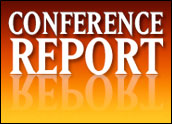
There’s an “elephant on the stage,” commented BusinessWeek columnist Steve Wildstrom as he kicked off theTech Policy Summit here in Hollywood, Calif.
Although several telecommunication companies have representatives in attendance, and although the FCC’s 700 MHz spectrum auction concluded recently, the companies involved aren’t yet permitted to divulge certain details of their plans for whatever portion of the airwaves they may have won. The auction is no doubt near the top of many attendees’ minds. However, those who know the most will have to keep quiet.
“We’ll just have to do our best and work around that,” said Wildstrom.
That’s not to say the US$19.6 billion auction is the only thing anyone’s talking about. The purpose of this gathering is to discuss the many intersections where public policy and technology meet — from copyright issues to public broadband to the presidential election in a Web 2.0 age. Members of telecom and media powerhouses are participating, along with contingents from Silicon Valley and Washington.
Sharing Progress
“What we’re trying to do with this event is to get together a cross-section of people — nonprofits, technologists and government officials — who normally don’t get together and have a discussion where they share their various perspectives with the goal of coming up with better policy solutions that enable tech innovations and adoption,” Marc Licciardi, vice president of the Tech Policy Summit, told TechNewsWorld.
The opening roundtable discussion took a wide-angle approach to introducing these topics, homing in on the ways enhanced collaboration and policy innovations can bring about economic growth. The panel featured representatives fromCompTIA,HP Labs, theUniversity of California and theKauffman Foundation.
“More and more companies in Silicon Valley have approached innovation in a very silent way, being very protective of what they own and being a little less collaborative,” explained Mozelle Thompson, CEO of Thompson Strategic Consulting and former FTC commissioner. He sees value in reconstructing an ethic for collaborative innovation, but noted that’s not going to be easy in a time of economic downturn.
“The business side doesn’t necessarily see the way forward as actually being more open than less open,” he said.
Also addressed were the limitations and sometimes failures of policy to accelerate technological innovation. Roger Cochetti, group director of U.S. policy at CompTIA, pointed to initiatives from both President George W. Bush and U.S. House Speaker Nancy Pelosi that he said have come up short in their 18 months of existence.
“A year and a half later, the results have been modest to say the least,” he remarked, citing problems like a lack of funding and a shortage ofH-1B visas. “I think it’s safe to say, from my experience, never has so much political agreement produced so little results.”
Patents and Innovation
The morning’s featured interview brought Wildstrom back to the stage to speak with Paul Jacobs, CEO of Qualcomm. In addition to his company’s ongoing patent battles and the future of new mobile devices, Jacobs spoke about licensing low-frequency bands to accommodate the growing demand for wireless data services.
Even after the FCC auction of high-frequency bandwidth, “there’s still more spectrum out there,” he noted.
He also advocated the expansion of the H-1B visa program, pointing to a “scary” new trend in immigration. He sees a tendency to educate top engineers and scientists in the U.S. but deny them the ability to stay, thereby creating hotspots of innovation overseas that often compete with domestic startups for U.S. venture capital funding.
Jon Dudas, the undersecretary of commerce for intellectual property and a director at the United States Patent and Trademark office, delivered the first keynote address, outlining threats to the U.S. intellectual property system.
“You all are working globally … and intellectual property is not working globally,” he said.
Markets and supply chains are seamlessly global, he asserted, but one bottleneck standing in the way of private sector innovation is the process they must go through to protect intellectual property in each individual nation where they want to do business. Protection in each country is determined by its own patent system — and some are more effective than others.
However, “one patent for the world is a long way off,” he stated. One solution may be to work more closely with foreign patent offices — for example, through the so-called prosecution highway, an agreement with certain other countries to accelerate the examination process when complaints are filed.
Another remedy, Dudas said, might be to bring fast-growing patent offices in places like China and South Korea up to speed. “Countries are going to have to adopt best practices and change laws.”
Another Threat
The glut of unpatentable ideas vying for approval from his office is yet another threat. To put the situation in perspective, he noted that 72 percent of patent applications were approved in 2000; now, the figure stands at 43 percent.
“If you’re waiting in line for 40 months, 50 months, 60 months — over half of the applications in front of you in line are not patentable ideas,” commented Dudas.
The reason for the overflow, he asserted, is that many firms are more concerned with simply winning patents in order to please investors, regardless of whether an idea is useful or novel. The fix to this situation, as he sees it, is to raise the bar in terms of what information an applicant needs to submit when applying, and explain why they see this patent as useful or innovative.
“No one knows better than the applicant what they really have in mind,” he observed. “We want them to bring that in.”





















































